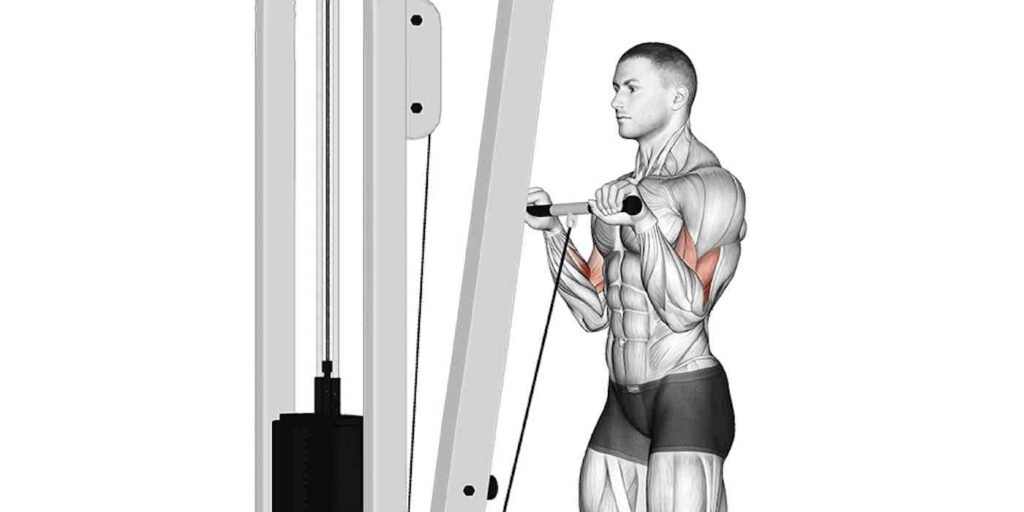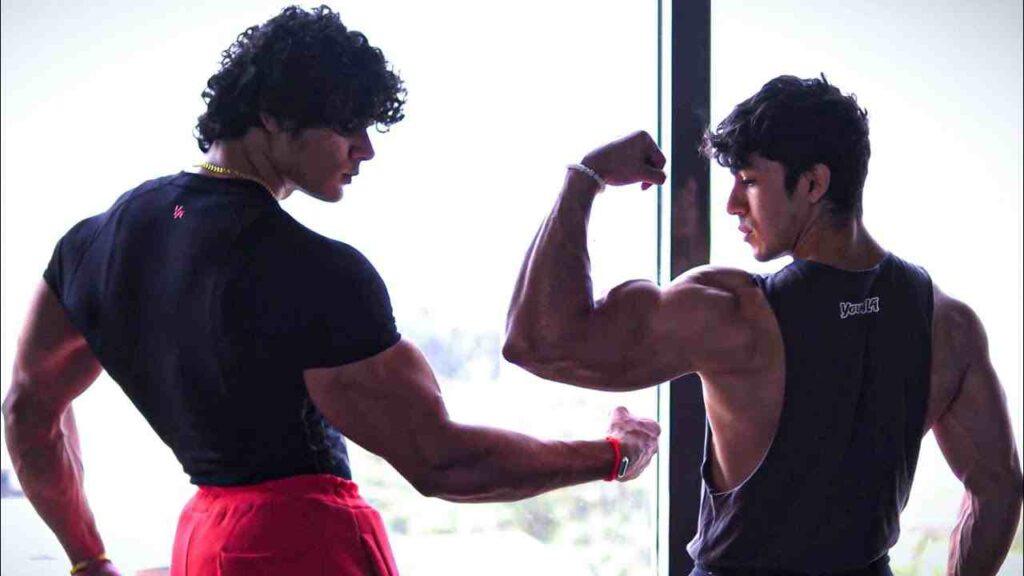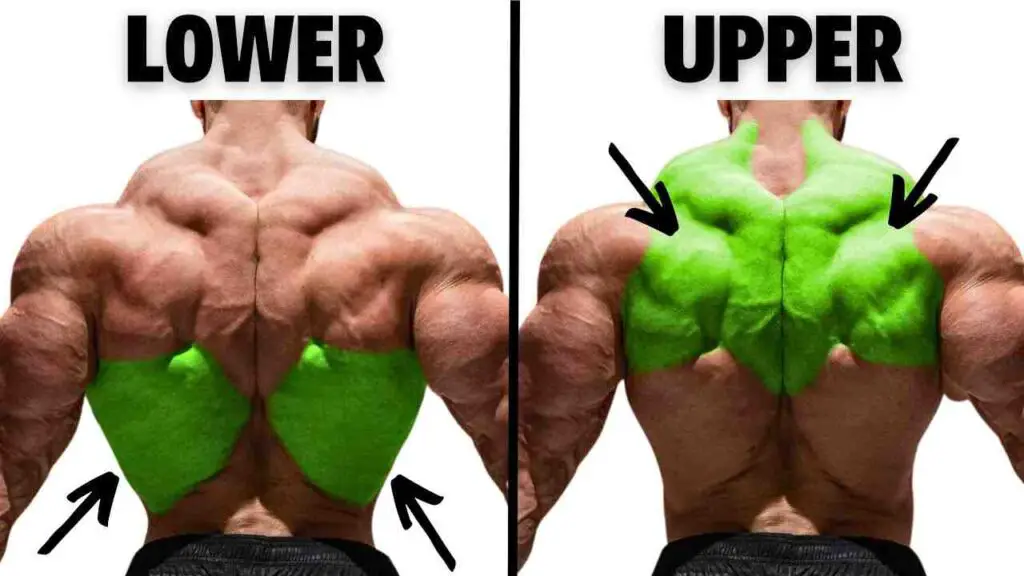Introduction
In the world of fitness, where each muscle group is important in its own right, the biceps have always been a focal point for individuals looking for strong, toned arms. Among the numerous workouts offered, one gem that is frequently overlooked is the “Reverse Cable Curl.” While traditional curls may take center stage, the reverse cable curl offers a unique set of features to the table. In this article, we will explore the reverse cable curl, shedding light on its significance, the muscles it engages, and the benefits it provides.
SHOP FOR THE ADJUSTABLE DUMBBELL SET ON AMAZON
The reverse cable curl has the potential to become a vital addition to your arsenal of workouts, whether you’re a seasoned lifter or a newbie just starting out on your fitness journey. Let’s unpack the complexities of this underappreciated workout and see what amazing outcomes it can help you attain.
Understanding Reverse Cable Curls

Reverse Cable Curl is a resistance training exercise designed to target the muscles of the upper arm, specifically the brachialis, brachioradialis, and biceps. Unlike traditional curls, where you curl the weight towards your body, reverse cable curls involve curling the weight away from your body. This unique motion engages different muscle fibers and helps in developing well-rounded bicep strength and definition.
Muscle Groups Targeted
Reverse Cable Curls primarily target three key muscles:
- Brachialis: This muscle lies beneath the biceps and plays a crucial role in elbow flexion. By targeting the brachialis, reverse cable curls contribute to a thicker and more prominent upper arm.
- Brachioradialis: Located on the forearm, the brachioradialis assists in both elbow flexion and forearm supination. Targeting this muscle provides forearm stability and strength.
- Biceps Brachii: While the biceps are still engaged in reverse cable curls, the unique angle of motion places more emphasis on the brachialis and brachioradialis. This balanced engagement contributes to overall arm aesthetics and strength.
In addition to these muscles, the reverse cable curl can also help to strengthen the forearms. The forearms are responsible for gripping and holding objects, so strengthening them can help to improve grip strength and prevent injuries.
Benefits of Reverse Cable Curls
Reverse cable curls might not be as popular as their traditional counterparts, but they offer a host of unique benefits that can greatly enhance your arm training routine. Let’s delve into the advantages of incorporating reverse cable curls into your workout regimen:
- Targeting Different Muscle Groups: Reverse cable curls primarily target the brachialis and brachioradialis muscles, which are often overlooked in traditional bicep exercises. By focusing on these muscles, you can achieve a more balanced and well-rounded development of your forearm and upper arm.
- Enhanced Forearm Development: The brachialis muscle lies beneath the biceps brachii and plays a crucial role in forearm flexion. Reverse cable curls put greater emphasis on this muscle, helping you build a more robust and defined forearm, which is essential for overall arm aesthetics and functional strength.
- Improved Grip Strength: Gripping the cable handle in the reverse position engages the forearm muscles and wrist extensors to a greater extent. This not only contributes to forearm development but also enhances your grip strength, which is essential for various daily activities and other exercises.
- Reduced Strain on the Wrists: Reverse cable curls are often considered more wrist-friendly than traditional curls. The pronated grip (palms facing down) used in this exercise allows for a more neutral wrist position, reducing the risk of wrist strain or discomfort.
- Functional Strength: The forearm and grip strength developed through reverse cable curls can be beneficial for everyday tasks, such as lifting objects, carrying groceries, and performing manual labor. This functional strength translates into improved overall physical performance.
- Injury Prevention: Strengthening the brachialis and brachioradialis muscles can contribute to joint stability and help prevent injuries, especially in the elbow and wrist areas. A balanced and strong musculature reduces the risk of imbalances that could lead to overuse injuries.
- Isolation and Mind-Muscle Connection: Reverse cable curls allow for better isolation of the target muscles. This isolation encourages a stronger mind-muscle connection, helping you focus on contracting the right muscles during each repetition for optimal results.
SHOP FOR THE CABLE MACHINE ON AMAZON
Reverse cable curls are a great way to build the brachialis muscle, improve grip strength, and prevent elbow pain. If you are looking for an effective arm workout, be sure to include reverse cable curls in your routine.
Proper Form and Technique

The reverse cable curl is an exercise that targets the forearms and biceps. It is performed by standing in front of a cable machine with a bar attachment attached to a low pulley. The bar is held with a pronated grip (palms facing down) and the elbows are kept close to the sides of the body. The weight is then curled up towards the chest, keeping the forearms in a fixed position. The reverse cable curl can be done with one arm or both arms at the same time.
Here are the steps on how to do a reverse cable curl with proper form:
- Stand facing a cable machine with your feet shoulder-width apart.
- Hold a bar attachment that is attached to a low pulley using a pronated grip (palms down). Your hands should be shoulder-width apart or slightly narrower, depending on your comfort.
- Keep your core engaged and maintain a slight bend in your knees.
- Keep your elbows close to your sides and slowly curl the weight up towards your chest. Pause at the top of the contraction.
- Then slowly lower the weight back down to the starting position.
- Repeat for the desired number of repetitions.
Common Mistakes to Avoid
Here are some common mistakes to avoid during reverse cable curl:
- Using too much weight. The goal of reverse cable curls is to work the forearm muscles, not the biceps. Using too much weight can put unnecessary stress on your forearms and increase your risk of injury.
- Using momentum. Don’t swing the weight up and down. This will not only make the exercise less effective, but it can also put stress on your wrists and elbows.
- Not keeping your wrists straight. Your wrists should be in a neutral position throughout the entire exercise. Bending your wrists can put stress on your forearm muscles and tendons.
- Not using a full range of motion. Make sure to curl the weight up until your knuckles are facing your shoulders. This will ensure that you are working all of the forearm muscles.
- Bending your elbows too much. Throughout the workout, keep your elbows slightly bent. Bending them too much can put stress on your biceps.
- Not engaging your core. Keeping your core engaged will help to stabilize your body and prevent injuries.
SHOP FOR THE RESISTANCE BAND ON AMAZON
Reverse cable curls are a great way to build strength and muscle in your forearms. By avoiding these common mistakes, you can ensure that you are doing the exercise correctly and safely.
Variations and Modifications
Here are some variations and modifications for the reverse cable curl:
Variations:
- Single-arm reverse cable curl: This variation allows you to focus on one arm at a time. To do this, attach a rope attachment to the high pulley of a cable machine and stand facing the machine with your feet shoulder-width apart. Grab the rope attachment with one hand, palm facing down, and bend your elbow to curl the rope attachment up towards your chest. Repeat on the other side.
- Wide-grip reverse cable curl: This variation targets the outer head of the biceps more. To do this, use a wider grip on the rope attachment.
- Narrow-grip reverse cable curl: This variation targets the inner head of the biceps more. To do this, use a narrower grip on the rope attachment.
- Weighted reverse cable curl: This variation makes the exercise more challenging by adding weight plates to the rope attachment.
- Reverse cable curl 21s: This is a challenging variation where you do 7 partial reps at the bottom of the range of motion, 7 partial reps in the middle of the range of motion, and 7 full reps.
- Pause reverse cable curl: This variation helps you focus on the contraction of the biceps by pausing at the top of the movement for a second or two.
Modifications:
- If you have any shoulder pain, you can perform the exercise with your elbows slightly bent. This will help to take some of the stress off of your shoulders.
- If you have any wrist pain, you can use a wrist wrap. This will help to support your wrists and prevent injury.
- If you are a beginner, you can start with light weights and gradually increase the weight as you get stronger. It is important to focus on proper form to avoid injury.
SHOP FOR THE FITNESS TRACKER ON AMAZON
The reverse cable curl is a great exercise for targeting the biceps and brachialis muscles. By varying the exercises and modifications, you can make it more challenging or easier to suit your fitness level and goals.
Incorporating Reverse Cable Curls into Your Workout Routine
Incorporating Reverse Cable Curls into your workout routine depends on your fitness goals and overall training program. For individuals looking to develop stronger forearms and enhance grip strength, performing Reverse Cable Curls 2-3 times a week can be effective. However, it’s important to avoid overtraining, as the forearms are relatively smaller muscle groups that can fatigue easily.
Pairing with Other Exercises
Here are some exercises that you can pair with reverse cable curls:
- Bicep curls: This is a classic exercise for targeting the biceps. You can do bicep curls with dumbbells, a barbell, or a cable machine.
- Hammer curls: This exercise targets the brachialis, which is the muscle that runs underneath the biceps. You can do hammer curls with dumbbells or a cable machine.
- Preacher curls: This exercise isolates the biceps and helps to build them up. You can do preacher curls with dumbbells or a preacher curl machine.
- Overhead triceps extensions: This exercise targets the triceps, which is the muscle that is on the back of the upper arm. You can do overhead triceps extensions with dumbbells, a barbell, or a cable machine.
- Close-grip bench press: This exercise also targets the triceps. It is a compound exercise that works multiple muscle groups in the chest, shoulders, and triceps.
You can pair these exercises together in a variety of ways. Here is a sample workout routine that includes reverse cable curls:
- Warm-up: Do 5-10 minutes of cardio followed by some dynamic stretches.
- Exercise 1: Reverse cable curls: 3 sets of 10-12 repetitions.
- Exercise 2: Bicep curls: 3 sets of 10-12 repetitions.
- Exercise 3: Hammer curls: 3 sets of 10-12 repetitions.
- Exercise 4: Preacher curls: 3 sets of 10-12 repetitions.
- Exercise 5: Overhead triceps extensions: 3 sets of 10-12 repetitions.
- Cool-down: Do 5-10 minutes of static stretches.
SHOP FOR THE BARBELL WEIGHTS ON AMAZON
This is just a sample routine, and you may need to adjust it depending on your fitness level and goals. Be sure to listen to your body and take breaks when needed.
Safety Precautions
Here are some safety precautions to take when doing reverse cable curls:
- Start with a light-weight. Reverse cable curls are an isolation exercise, which means they target a specific muscle group (the forearm). As such, you don’t need to use a lot of weight to get a good workout. Start with a weight that you can lift 8 to 12 times with proper form, and gradually increase the weight as you get stronger.
- Use a pronated grip. This means that your palms should be facing down as you grip the bar. A pronated grip helps to target the forearm muscles more effectively.
- Keep your upper arms stationary. As you curl the weight up, your upper arms should remain in place against your sides. This will help to protect your shoulders.
- Don’t use momentum. It’s tempting to use momentum to help you curl the weight up, but this can put stress on your joints. Instead, focus on using slow, controlled movements.
- Listen to your body. If you experience any pain, stop the exercise immediately.
Here are some additional tips for safety:
- Make sure the cable machine is properly adjusted so that the weight is not too heavy or too light.
- Stand with your feet shoulder-width apart and your back straight.
- Keep your core engaged throughout the exercise.
- Do not arch your back.
- Do not allow your wrists to bend back.
If you have any concerns about safety, talk to your doctor or a certified personal trainer.
Overall, reverse cable curl is a safe and effective exercise for building forearm muscle and improving grip strength. By following the safety precautions listed above, you can help to reduce your risk of injury.
FAQs
Q 1. Is this exercise suitable for beginners?
Ans. Absolutely! Reverse cable curls can be adapted for beginners by starting with lighter weights and focusing on proper form. It’s essential to start with a weight that allows you to perform the exercise with control and without straining your muscles.
Q 2. Can reverse cable curls help with forearm development?
Ans. Yes, reverse cable curls are excellent for targeting the brachioradialis and brachialis muscles in the forearms. By incorporating this exercise into your routine, you can enhance forearm strength and definition over time.
Q 3. What’s the difference between reverse cable curls and regular cable curls?
Ans. The primary difference lies in the grip and the muscle emphasis. Reverse cable curls involve a pronated grip (palms facing down), targeting the brachialis and brachioradialis muscles more than the biceps. Regular cable curls use a supinated grip (palms facing up), placing a greater focus on the biceps.
Q 4. Are reverse cable curls safer than traditional curls for people with wrist issues?
Ans. Yes, for individuals with wrist issues, reverse cable curls can be a safer alternative to traditional curls. The pronated grip reduces stress on the wrists, making it a more comfortable option for those with wrist discomfort or injuries.
Q 5. How long does it take to see results from reverse cable curls?
Ans. Results vary depending on factors such as your overall fitness level, diet, genetics, and workout consistency. With proper training and a balanced lifestyle, you may begin to notice improvements in forearm and bicep strength and definition within a few weeks to a couple of months.
Q 6. Should I perform reverse cable curls on their own or with other exercises?
Ans. Incorporating reverse cable curls into a comprehensive bicep and forearm workout routine is recommended for balanced muscle development. Pairing them with other exercises like regular curls, hammer curls, and compound movements can contribute to overall upper body strength.
Conclusion
Reverse cable curls might be the missing piece in your quest for perfectly sculpted biceps. By understanding the nuances of this exercise, perfecting your form, and tailoring it to your fitness level, you’ll be well on your way to achieving your desired results.
Remember, the key to success lies in consistency and a well-rounded approach to your fitness journey. So, grab that cable handle and start incorporating reverse cable curls into your routine – your biceps will thank you later!

Good day, and welcome to Fitthour. My name is Shubham Vijay, and I am a certified personal trainer and nutrition coach with 6 years of experience in the fitness industry. At Fitthour, we specialize in types of training, such as strength training, cardio, or HIIT, and our mission is to help clients achieve their fitness goals and improve their overall health.




